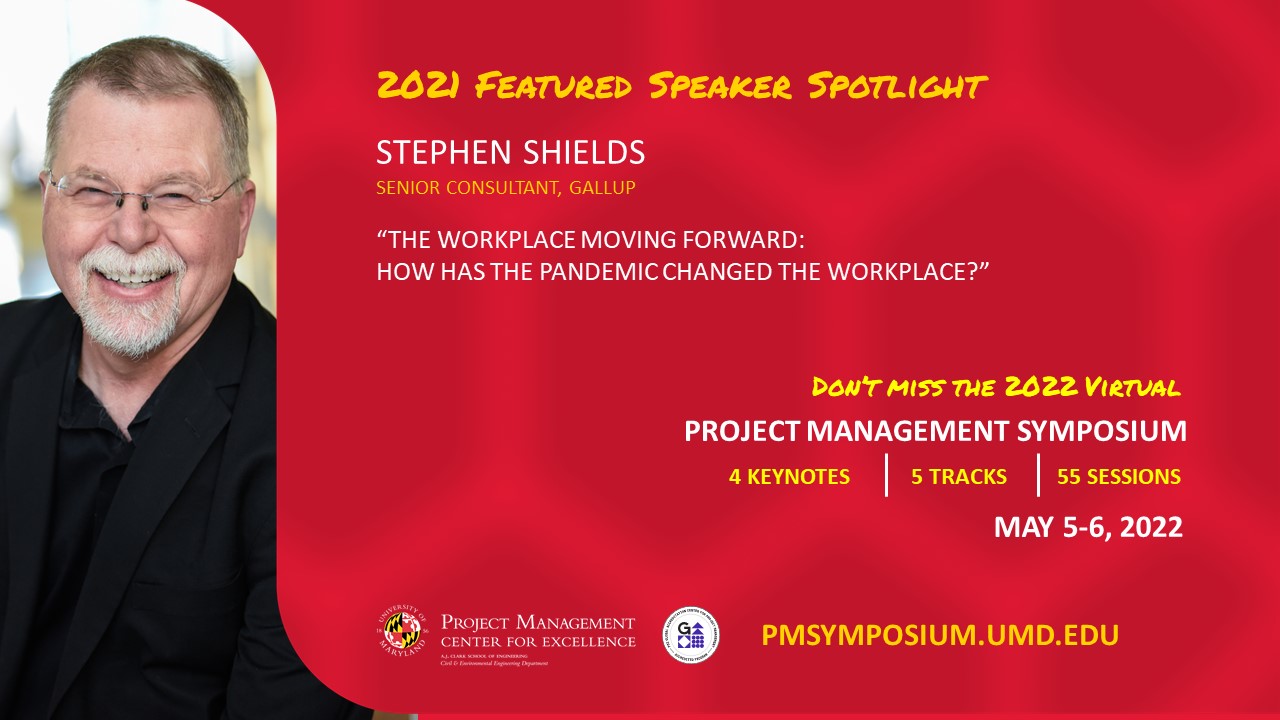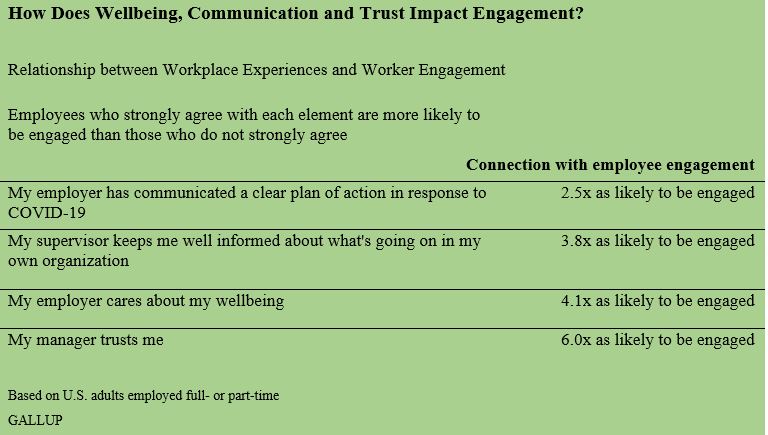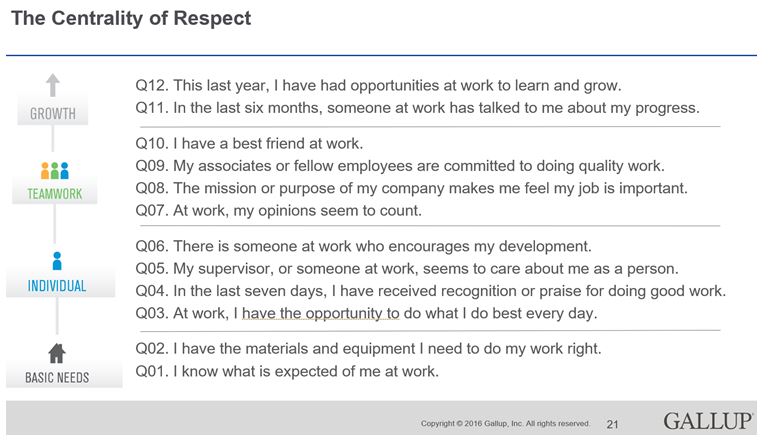In our 2021 Virtual Project Management Symposium, we continued the idea that one of our featured speakers would address issues around the workplace. In 2019, Stephen Shields, a Gallup Senior Consultant, lead an energizing breakout session on “Thriving Strengths-based Leaders” so, for 2021, we invited him as a featured speaker to discuss “The Workplace Moving Forward: How has the Pandemic Changed the Workplace?”

When millions of Americans suddenly began working remotely due to the COVID-19 pandemic, managers acquired trial-by-fire experience with at-home work policies. As we move forward in a post-pandemic workplace, some of those experiences are useful, others are best left behind. Managing a team in person is challenging enough but moving all operations to virtual platforms has had significant and swift effects on workplace culture.
Shields said that unemployment levels rose to almost twice what they were pre-pandemic, and that within just three weeks between mid-March to April 2020, the percentage of American employees working from home doubled, from 31% to 62%. By February of 2021, that number dipped only slightly to 58%, representing employees who are still working remotely.
The rapidity of these changes posed a particular problem. While workplace culture does not always change rapidly, a crisis does offer the opportunity for convulsive change that would otherwise take much longer. Drastic adjustments generally occur much more slowly and over much longer periods of time.
Starting March 2020, in response to the mandates for shutdowns, organizations globally had to abandon their basic work models, sometimes within just a few days. Surveys reported that about half the workforce did not feel prepared to work remotely. They felt forced to continue working while essentially improvising with an unprecedented set of circumstances.
Managing a team in person is challenging enough but moving all operations to virtual platforms has had significant and swift effects on workplace culture.
A survey, taken from March to September 2020, randomly sampled over 5,000 full-and part-time employees. During this time, employee engagement began at 37%, rose to 40%, and then fell again to 36%. Employee active disengagement started at 15%, then fell and remained mostly steady at 13%. Shields said the Gallup poll’s results reflected employee engagement was all over the place.
Employee engagement is important because it is a commitment by an employee to fully embrace the goals of the company. Employee engagement is a critical factor in their happiness and productivity. Conversely, employee active disengagement means that employees are very dissatisfied with their job and will perform poorly unless they are just calling out sick or not working at all. They could be angry with their work environment, their co-workers, their leadership, or perhaps all three.
Register for the 2022 Virtual Project Management Symposium Today
For additional context about the emotional dynamics that managers must address, Shields referenced the research of Daniel Kahneman’s book, “Thinking Fast and Slow[1],” which explores how we make decisions, which offers a backdrop to employee engagement survey results. Kahneman revealed that most of our decisions are emotional. As a consequence, culture matters. Similarly, engagement matters. All employees fall somewhere on an emotional spectrum, starting with passionately engaged, bored, or actively disengaged.
The percentage of “engaged” and “actively disengaged” employees changed more drastically during the pandemic than during the Iraq War or during the attacks of September 11, 2001. The global recession, the preponderance of people working from home, and the cataclysm that precipitated it created more variability in terms of employee engagement than has been seen in recent times. Those managers who understand the implications of Kahneman’s research appear to have been able to manage their teams with the best outcomes.
Kahneman’s research, explored more thoroughly in Dr. Shari DeBaet’s presentation during UMD’s 2021 Virtual Project Management Symposium, paved a segue from traditional “logical” economics to behavioral economics. Management expert and author Peter Drucker aptly said, “Culture eats strategy for breakfast.” Kahneman’s research bears it out: Neurologically, human beings make decisions from an emotional and intuitive base. If people are rolling their eyes and shrugging shoulders in a meeting, those disrespectful responses will precipitate an emotional response that will destroy any “logic-based” plan.
Managing emotions and intuitions of those who report to managers is critical to the success of any project, whether it’s a solid or dotted-line relationship. It is not possible to successfully manage people as though they were simply logical robots, yet under the classical rubric, that’s exactly how we’ve been taught to manage.
If people’s decisions are driven by emotion and intuition, then managers must develop an emotional relationship with their teams, the foundation of which is respect. Shields said that 70% of variation in team-level engagement is attributable to the local manager. It is simple: Bad managers make people miserable. The key to high-level team engagement is for managers to work on quality of culture and treating people in a respectful — not just superficially “nice” or “courteous” manner.
Shields explained the difference. A nice or courteous boss will always have a pleasant conversation with you. Perhaps he or she will even hold the door open for you as you walk down the hall together, or they will have coffee with you. But they will be reluctant to bring up real difficulties.
This, he pointed out, is superficial courtesy, not respect. If a boss does not address disagreements or difficulties, that is disrespectful to the employee and the team. To have tough conversations about poor job performance or conflict in a respectful way that preserves the dignity of everyone involved is part of good leadership. For good leaders, dignity and respect are toggles that are always in the “on” position, even when it is necessary to share uncomfortable information. To fall short is detrimental to the company’s mission.
In a poll question asking workers’ view of how leaders can create this sense of high engagement during times of change, responses were clear: Leaders who kept employees’ health and wellbeing front and center, communicated continually, and trusted the talent on their teams were most successful in navigating through the chaos of change.

Further, it is not generally possible to overcommunicate. In a change-management situation, it does not suffice for the employees to simply read an email from their CEO. It is unlikely that the CEO knows them personally. But their local supervisor or manager does, and that is the person who needs to be available for discussions about what the change will mean for them.
This is why 10,000 people surveyed characterized their “best boss” as one who offered stability, compassion, trust and hope—all emotionally rooted words, which again affirms Kahneman’s research that people are emotional and intuitive, not robotic and logical. It also underscores that culture does, in fact, eat strategy for breakfast.
Register for the 2022 Virtual Project Management Symposium Today
Gallup conducted a poll asking part and-full-time employees to respond to how wellbeing, trust and communication impacts their engagement. The results indicated that employees who felt their employer communicated a clear plan of action in response to COVID-19, kept them well informed, cared about their wellbeing, and trusted them were more likely to be highly engaged in their job performance.
Your employees’ level of engagement pays off financially, as well as in terms of optimal workplace culture.
Your employees’ level of engagement pays off financially, as well as in terms of optimal workplace culture. In a 12-question survey (see slide below) of over 2.7 million people in 54 industries in 96 countries, there were 41% fewer mistakes amongst those who were most engaged with their work. This translates into high dollars. But why would culture affect that? It’s Kahneman again: Our decisions are emotional and intuitive, and that affects the productivity of the brain.

Shields said two survey questions in particular were significant indicators of employee engagement: One asks whether employees feel their supervisor or someone at work cares about them as persons; and another, asks whether employees feel that their opinions at work count. What connects those two responses is respect. If there are disagreements in the workplace, but employees believe their input has been weighed accordingly, employees are more likely to feel that their boss cares about them as persons and be assured their opinions mattered.
Certainly, some employees will prefer to work remotely, and some will strongly prefer to work in the office, but generally when given the choice for flexibility most employees feel that they would like most to work 2-3 days from home, and 2-3 days in their office. This is optimal in terms of employee engagement, and therefore productivity, and this has been confirmed in post-pandemic polling. The appetite for working from home has increased, and it is directly relevant to the question of engagement, but it’s not possible to manage people simply from an information standpoint. To create a highly engaged employee in a productive work environment, leaders must be flexible and learn to manage the whole person.
The pandemic has certainly changed the workplace. Many individuals have learned that they really like the flexibility of working from home and many employers have learned that productivity was not compromised. Working remotely is, of course, a function of the specific nature of the job and individual preferences. In either case, employee satisfaction and engagement are directly tied to leaders and managers who kept employees’ health and wellbeing front and center, communicated continually, and trusted the talent on their teams.
Watch Stephen Shield’s full presentation from the University of Maryland’s 2021 Virtual Project Management Symposium.
If you are interested in presentations like this, plus presentations on a variety of Project Management topics, check out the University of Maryland’s VIRTUAL Project Management Symposium to be held May 5-6, 2022. The event will feature 4 keynote speakers and 55 individual sessions in 5 concurrent tracks. More information can be found at the 2022 Virtual Project Management Symposium website. If you want access to the recordings from the 2021 Virtual Project Management Symposium, you can register for access for only $150.
Register for the 2022 Virtual Project Management Symposium Today

This article appeared in PM World Journal, Vol. X, Issue VIII, September 2021.
How to cite this article: Cable, J. H. (2021). The Workplace Moving Forward: How the Pandemic Changed the Workplace, PM World Journal, Vol. X, Issue VIII, September.
[1] Thinking Fast and Slow by Daniel Kahneman published in 2011 by Farrar, Straus, and Giroux ISBN 978-0374275631
Posted by Kathy Frankle on September 7, 2021

 Data Analytics for the Project Manager
Data Analytics for the Project Manager